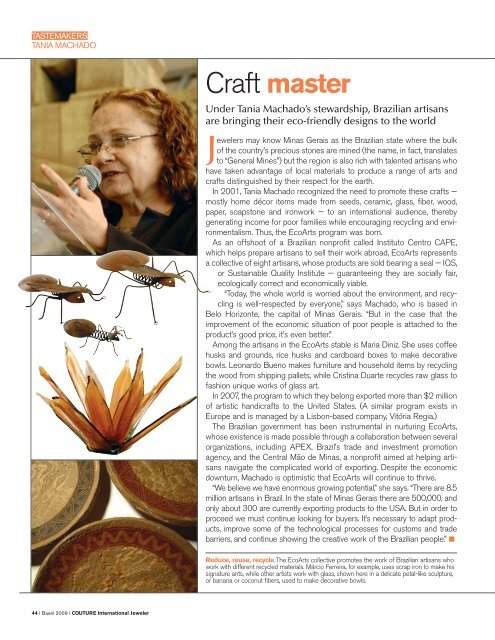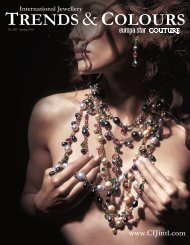FOR iPad > OPEN IN IBOOKS - CIJintl.com
FOR iPad > OPEN IN IBOOKS - CIJintl.com
FOR iPad > OPEN IN IBOOKS - CIJintl.com
Create successful ePaper yourself
Turn your PDF publications into a flip-book with our unique Google optimized e-Paper software.
TASTEMAKERS<br />
TANIA MACHADO<br />
44 l Basel 2009 l COUTURE International Jeweler<br />
Craft master<br />
Under Tania Machado’s stewardship, Brazilian artisans<br />
are bringing their eco-friendly designs to the world<br />
Jewelers may know Minas Gerais as the Brazilian state where the bulk<br />
of the country’s precious stones are mined (the name, in fact, translates<br />
to “General Mines”) but the region is also rich with talented artisans who<br />
have taken advantage of local materials to produce a range of arts and<br />
crafts distinguished by their respect for the earth.<br />
In 2001, Tania Machado recognized the need to promote these crafts —<br />
mostly home décor items made from seeds, ceramic, glass, fiber, wood,<br />
paper, soapstone and ironwork — to an international audience, thereby<br />
generating in<strong>com</strong>e for poor families while encouraging recycling and environmentalism.<br />
Thus, the EcoArts program was born.<br />
As an offshoot of a Brazilian nonprofit called Instituto Centro CAPE,<br />
which helps prepare artisans to sell their work abroad, EcoArts represents<br />
a collective of eight artisans, whose products are sold bearing a seal — IQS,<br />
or Sustainable Quality Institute — guaranteeing they are socially fair,<br />
ecologically correct and economically viable.<br />
“Today, the whole world is worried about the environment, and recycling<br />
is well-respected by everyone,” says Machado, who is based in<br />
Belo Horizonte, the capital of Minas Gerais. “But in the case that the<br />
improvement of the economic situation of poor people is attached to the<br />
product’s good price, it’s even better.”<br />
Among the artisans in the EcoArts stable is Maria Diniz. She uses coffee<br />
husks and grounds, rice husks and cardboard boxes to make decorative<br />
bowls. Leonardo Bueno makes furniture and household items by recycling<br />
the wood from shipping pallets, while Cristina Duarte recycles raw glass to<br />
fashion unique works of glass art.<br />
In 2007, the program to which they belong exported more than $2 million<br />
of artistic handicrafts to the United States. (A similar program exists in<br />
Europe and is managed by a Lisbon-based <strong>com</strong>pany, Vitória Regia.)<br />
The Brazilian government has been instrumental in nurturing EcoArts,<br />
whose existence is made possible through a collaboration between several<br />
organizations, including APEX, Brazil’s trade and investment promotion<br />
agency, and the Central Mão de Minas, a nonprofit aimed at helping artisans<br />
navigate the <strong>com</strong>plicated world of exporting. Despite the economic<br />
downturn, Machado is optimistic that EcoArts will continue to thrive.<br />
“We believe we have enormous growing potential,” she says. “There are 8.5<br />
million artisans in Brazil. In the state of Minas Gerais there are 500,000, and<br />
only about 300 are currently exporting products to the USA. But in order to<br />
proceed we must continue looking for buyers. It’s necessary to adapt products,<br />
improve some of the technological processes for customs and trade<br />
barriers, and continue showing the creative work of the Brazilian people.” ■<br />
Reduce, reuse, recycle The EcoArts collective promotes the work of Brazilian artisans who<br />
work with different recycled materials. Márcio Ferreira, for example, uses scrap iron to make his<br />
signature ants, while other artists work with glass, shown here in a delicate petal-like sculpture,<br />
or banana or coconut fibers, used to make decorative bowls.



